
Re: Silo Discharge Rate-Reg.
Don't most alumina silos have multiple outlets? If you decide to fit another 2 outlets it shouldn't involve much additional CAPEX and your OPEX will soon recover. ■
Alumina Et. Al.
Louis- I think most of his problem is loss of mass flow due to loss of weight of material.
A small double drum slusher scoop with several sheave blocks in the silo to allow side movement of the bucket may be the answer to allow full or nearly complete removal of the alumina.
Option two may be a simple hand held air lance(100 PSI) to move the alumina to the outlets-but if he does not have a cat walk around the inside perimeter of the silo that may not be possible if there is not means of entry at or near ground level.
lzaharis ■
Re: Silo Discharge Rate-Reg.
It appears that you are experiencing a reduction in rate as a result of compaction pressure. The weight of headload is squeezing air from the voids of material located in the bottom of the silo.
Is the aeration present only when discharging, or is aeration applied whenever there is material in the silo?
I recommend as an easy experiment to apply the aeration whenever the silo has material, especially when loaded more than 5000 MT. This will help replace or limit the air lost due to compaction pressure. ■
Re: Silo Discharge Rate-Reg.
There are number of issues with this system.
The silo is squat the bigger diameter has lot of influence on generating higher stresses in the material hence you can fill it up much.
Sandy Alumina does not respond much to aeration that is another reason you are not getting the discharge.
Last but not least when the aeration is used as a silo discharge it is always designed on any upward velocity
and your aeration system falls short on it by miles. ■
Re: Silo Discharge Rate-Reg.
Originally posted by D.NITHYANANDAN.
Sir,
Sub.: Silo discharge rate- Reg.
We have a ship loading system and handling Alumina. Our system is designed for 2000 MT/hr. We store Alumina in a concrete silo of storing capacity 22000 MT. While loading a ship, we could not extract more than 1000 MT/hr., and once the Alumina inside the silo reaches 5000 MT, we could not extract more than 400 MT/hr. from the silo. Other details in this regard are as follows,
Material handled : Calcined Alumina
Bulk density : 1.04 t/cu.m
Angle of repose : 22 deg.
Angle of surcharge : 10 deg.
Granulometry : Dry and Sandy
Size : -125 microns
Silo
Concrete in construction with flat bottom
Diameter 35 m
Wall thickness 350 mm
Height 33 m
Storing capacity 22000 MT
About 450 nos. of open Air slides of size 200 mm wide x 2.5 m long x 100 mm height are installed at 8 deg. Slope on silo floor. These 450 Air slides are divided into 8 segments for aeration (56 Air slides in each segment)
Aeration is through cyclic PCV’s for opposite segments at a time (2 segments in total) for a period of 5 min.
Silo discharge is through a distributor of Dia. 3 m with synthetic fabric installed at the centre of silo and 4 nos. of Flow Control Gates.
A Steel cone is installed above the distributor in such a way that 1m gap is maintained between silo floor and cone plate.
Root Blowers
Pressure : 0.63 bar
Volume : 600 cu.m/hr.
No. Of blowers : 3
Our queries are:
1.How to improve the discharge rate
2.How to improve the discharge rate once the silo stock reaches 5000 MT
3.How to reduce the substantial qty. of dead stock inside the silo (about 1000 MT)
Kind sir- the private message system is not working as yet due to software issues as I understand it. Please send your message to me via e-mail
Many thanks
lzaharis@lightlink.com ■
Re: Silo Discharge Rate-Reg.
Originally posted by D.NITHYANANDAN.
Sir,
Sub.: Silo discharge rate- Reg.
We have a ship loading system and handling Alumina. Our system is designed for 2000 MT/hr. We store Alumina in a concrete silo of storing capacity 22000 MT. While loading a ship, we could not extract more than 1000 MT/hr., and once the Alumina inside the silo reaches 5000 MT, we could not extract more than 400 MT/hr. from the silo. Other details in this regard are as follows,
Material handled : Calcined Alumina
Bulk density : 1.04 t/cu.m
Angle of repose : 22 deg.
Angle of surcharge : 10 deg.
Granulometry : Dry and Sandy
Size : -125 microns
Silo
Concrete in construction with flat bottom
Diameter 35 m
Wall thickness 350 mm
Height 33 m
Storing capacity 22000 MT
About 450 nos. of open Air slides of size 200 mm wide x 2.5 m long x 100 mm height are installed at 8 deg. Slope on silo floor. These 450 Air slides are divided into 8 segments for aeration (56 Air slides in each segment)
Aeration is through cyclic PCV’s for opposite segments at a time (2 segments in total) for a period of 5 min.
Silo discharge is through a distributor of Dia. 3 m with synthetic fabric installed at the centre of silo and 4 nos. of Flow Control Gates.
A Steel cone is installed above the distributor in such a way that 1m gap is maintained between silo floor and cone plate.
Root Blowers
Pressure : 0.63 bar
Volume : 600 cu.m/hr.
No. Of blowers : 3
Our queries are:
1.How to improve the discharge rate
2.How to improve the discharge rate once the silo stock reaches 5000 MT
3.How to reduce the substantial qty. of dead stock inside the silo (about 1000 MT)
Greetings and salutations D. Nithyananadan,
I agree with mantoo, Mr. Delmar and Louis Panjang with their thoughts regarding compaction of your alumina in your silo.
By limiting(reducing) the amount of alumina in the silo- the tonnage stored prior to discharge that will help a lot as it will not have the opportunity to compact as quickly.
You will reduce your compaction problem and increasing your flow rate at the same time it is a problem due to the aluminas ability to compact upon itself with relative ease, rock salt does the same thing.
So its a typical "opportunity cost" problem-
where you give something up to get something else;
A reduction of stored alumina and reduce total flow to maintain a flow rate of some mininum.
A rehabilitation of the interior silo may be an eventual option by reducing the inside diameter with a round insert with stays supported by the original silo wall and adding additional air slides at the same time.
lzaharis ■
Re: Silo Discharge Rate-Reg.
Hi there,
Quick question: Are the blower pressure relief valves blowing off at all especially when the alumina in the silo is at maximum compaction? I have seen this phenomenon before and you may not aerate the material at a rate necessary to promote material flow out of the silo. ■
Re: Silo Discharge Rate-Reg.
Hello lzaharis,
I got your private e-mail, but I think there is still a problem with the Forum's private message server. If desired use this e-mail address: rweiser@aerzenusa.com
Regards, ■
Silo Discharge
From some rough, preliminary calculations, it would seem that the distance between the air slides adjacent to the central cone is about one Meter and at the outer periphery of the silo about 13.5 Meters. The residual product in the silo will form a radial ridge between each air slide with a common drained repose angle, so the height of the ridge is proportional to the width between the air slides and will be a maximum on the outer radius, say ‘H’ High. The volume of this mass left between each of the air slides is approx. 116xH cubic meters, eight section of which comprise the total residue of 928xH cub. M. of product that is left in when the silo is ‘totally discharged’. If there were only 1000 Te left at a density of 1.04 Te/cub.M, this would equate to a maximum height only slightly greater than One Meter, indicating a drained angle of repose of about 4.4 degrees, clearly much less than may be expected. Even at the low drained slope angle of 22 degrees, the residual content of the silo would be over 5,000 Te, so the potential retrievable contents would seem to be more valuable.
Cross slides three meters in from the outside silo wall, joining to the radial slides, or an air cannon in the centre of this point may be a cheap way of reclaiming a reasonable proportion of this residue, but there is considerable scope for examining other prospects on a cost/return basis.
As to increasing the discharge rate, one would look to the sequence of operation of air slide sectors to see if activation can be applied to more than two slides, but possibly not over their full length. The application would appear to warrant spending a little on a consultancy. ■
Application Assistance
If you can send some good photos of the inside of the silo I can offer our assistance for some air cannon placement.
Air cannons are very affective when timers and placement are set up correctly. I can help achieve maximum flow rates at any level.
Use this email for reply info@vibco.com ■
Re: Silo Discharge Rate-Reg.
Dear D.,
Thank you for your private message, but thye system is still not working properly. Please send e-mails to this address and I will try answering you promptly: rweiser@aerzenusa.com
Have a great week. ■
Improvements In Silo Discharge Rates
To both maximise on discharge rates and also to prevent material build up on the side wall you should try installing cleaners which keep the material 'excited' without causing any structural damage. Typically higher frequency acoustic cleaners such as the PAS-350 and PAS-230 are installed near the outlet of the silo (see attached photo) and powerful, our frequency Models such as the PAS-75 or PAS-60 installed on top (again see photo). For further information and to complete silo questionnaire please go to the following site -
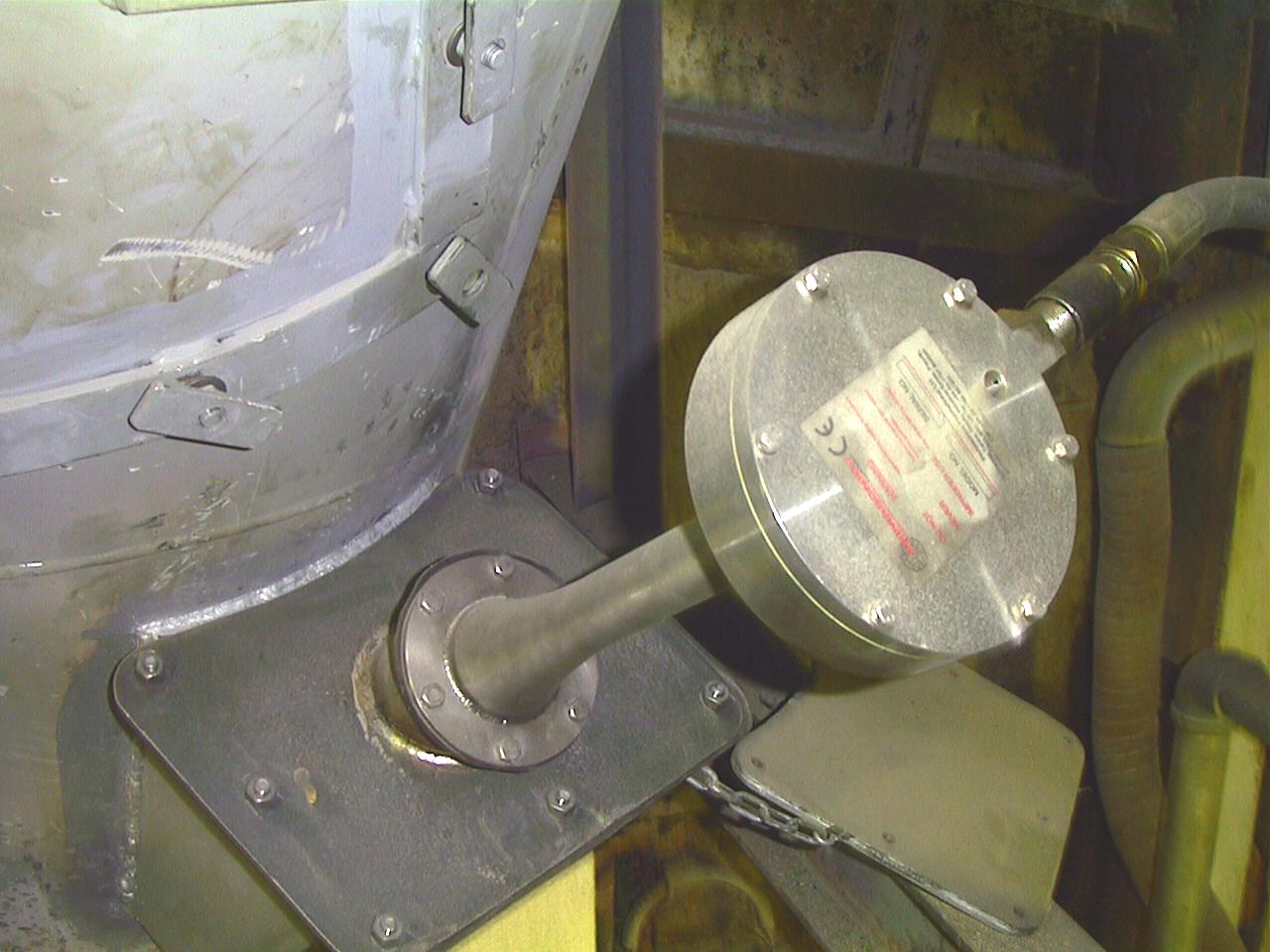
href="http://www.primasonics.com" target="blank">www.primasonics.com
Best regards
Donald Cameron
Primasonics International
Attachments
■
Re: Silo Discharge Rate-Reg.
Have you contacted IBAU or Claudius Peters for thier advice
The silo is squat...others have commented on the airslide spacing.......maybe the designer/suppliers tried to limit costs by limit airslides.
We had issues with a silo for raw meal - we ended up with MORE aeration and also split the aearated sections - as the air will flow to the region of least resistance....what is the type of fabric - cloth or needlefelt....
What happens at 5000T residual - is this a step drop or a gradual drop off in rate...???
Do you have a standby blower that our could program to run all the time...
Can you experiment with the aearation pattern/sequence and timing...
You say that have a acone/hood over the central outlet - how do you de-dust the volume - you are adding air....either it comes out with the product or you have to vent it.
You should try some experiments and see what happens
James ■
Silo Discharge
In my view the geometry of the air slides and the fluidisation velocity achieved needs attention.
The surface area of the 448 airslides covers some 24 % of the silo bottom. In our experience , a coverage of approx 50% is needed to get the air to distribute and fluidise evenly .
Next , the airvelocity with 3 x 600 m3/hr into 8 segments of 56 airslides each gives approx 0.018 m/sec airvelocity . For a heavy material as alumina , this may not be adequate to fluidise adequately . An estimate of appropriate fluidisation velocity will need data on particle size and pure density - but a rough guess will be some 0.03 - 0.04 m/sec air velocity out of the airslides when 50% aeration coverage is achieved on the silo base. If the blowers have speed tolerance available - changing the motors to higher power and modifying pulley ratio may help in raising airvolume keeping the blowers in place . For 50% coverage , more blowers must be put in tandem .
Since the aeration is segmented, the material will aerate in columns - and collapse - as the segments switch . So the output will not be uniform . But this is phenomena in almost all segmented silo extraction systems . Increasing the number of segments will improve this behaviour - but it is a matter of cost - and what is the downstream equipment into which the extracted material go into . ■
Bottleneck With Extraction From Alumina Silo
Sub.: Silo discharge rate- Reg.
We have a ship loading system and handling Alumina. Our system is designed for 2000 MT/hr. We store Alumina in a concrete silo of storing capacity 22000 MT. While loading a ship, we could not extract more than 1000 MT/hr., and once the Alumina inside the silo reaches 5000 MT, we could not extract more than 400 MT/hr. from the silo. Other details in this regard are as follows,
Material handled : Calcined Alumina
Bulk density : 1.04 t/cu.m
Angle of repose : 22 deg.
Angle of surcharge : 10 deg.
Granulometry : Dry and Sandy
Size : -125 microns
Silo
Concrete in construction with flat bottom
Diameter 35 m
Wall thickness 350 mm
Height 33 m
Storing capacity 22000 MT
About 450 nos. of open Air slides of size 200 mm wide x 2.5 m long x 100 mm height are installed at 8 deg. Slope on silo floor. These 450 Air slides are divided into 8 segments for aeration (56 Air slides in each segment)
Aeration is through cyclic PCV’s for opposite segments at a time (2 segments in total) for a period of 5 min.
Silo discharge is through a distributor of Dia. 3 m with synthetic fabric installed at the centre of silo and 4 nos. of Flow Control Gates.
A Steel cone is installed above the distributor in such a way that 1m gap is maintained between silo floor and cone plate.
Root Blowers
Pressure : 0.63 bar
Volume : 600 cu.m/hr.
No. Of blowers : 3
Our queries are:
1.How to improve the discharge rate
2.How to improve the discharge rate once the silo stock reaches 5000 MT
3.How to reduce the substantial qty. of dead stock inside the silo (about 1000 MT)
Dear Sir
From your problem it seems you are located in Southern part of India (in AP) and if I am right I have already visited your port and had discussed simple solutions with your HOD.
However we can undertake the project to ensure that you obtain the correct silo extraction rates.
I would request that you may kindly contact us directly by e-mail : office@frigate.in. Be rest assured that we have the solution to your problem. If I guessed you correctly, I had also discussed (at your port) issues related to the telescopic chute of the ship loader.
Thanks & Best Regards ■
Re: Silo Discharge Rate-Reg.
HI,friends.
I think we must know the reason why it can't reach.
some reasons: self-flowing angle.
Best regards
Joe ■
Sonic Horn
you can't get enough flow out of the silo.
is it caused by bridging and ratholing in silo? if it happens in your silo, definitely you will not get the designed data.
acoustic cleaning by sonic horn is a good idea.
you can get smooth material flow and even discharge with it. ■
Mass Flow Silo Discharge _Bring Material To The Center
Sub.: Silo discharge rate- Reg.
We have a ship loading system and handling Alumina. Our system is designed for 2000 MT/hr. We store Alumina in a concrete silo of storing capacity 22000 MT. While loading a ship, we could not extract more than 1000 MT/hr., and once the Alumina inside the silo reaches 5000 MT, we could not extract more than 400 MT/hr. from the silo. Other details in this regard are as follows,
Material handled : Calcined Alumina
Bulk density : 1.04 t/cu.m
Angle of repose : 22 deg.
Angle of surcharge : 10 deg.
Granulometry : Dry and Sandy
Size : -125 microns
Silo
Concrete in construction with flat bottom
Diameter 35 m
Wall thickness 350 mm
Height 33 m
Storing capacity 22000 MT
About 450 nos. of open Air slides of size 200 mm wide x 2.5 m long x 100 mm height are installed at 8 deg. Slope on silo floor. These 450 Air slides are divided into 8 segments for aeration (56 Air slides in each segment)
Aeration is through cyclic PCV’s for opposite segments at a time (2 segments in total) for a period of 5 min.
Silo discharge is through a distributor of Dia. 3 m with synthetic fabric installed at the centre of silo and 4 nos. of Flow Control Gates.
A Steel cone is installed above the distributor in such a way that 1m gap is maintained between silo floor and cone plate.
Root Blowers
Pressure : 0.63 bar
Volume : 600 cu.m/hr.
No. Of blowers : 3
Our queries are:
1.How to improve the discharge rate
2.How to improve the discharge rate once the silo stock reaches 5000 MT
3.How to reduce the substantial qty. of dead stock inside the silo (about 1000 MT)
10 years ago you asked ...
Just for adding another view to this knowlwgde/solution-bank I show this pictures to resume another possiblility to get mass flow:
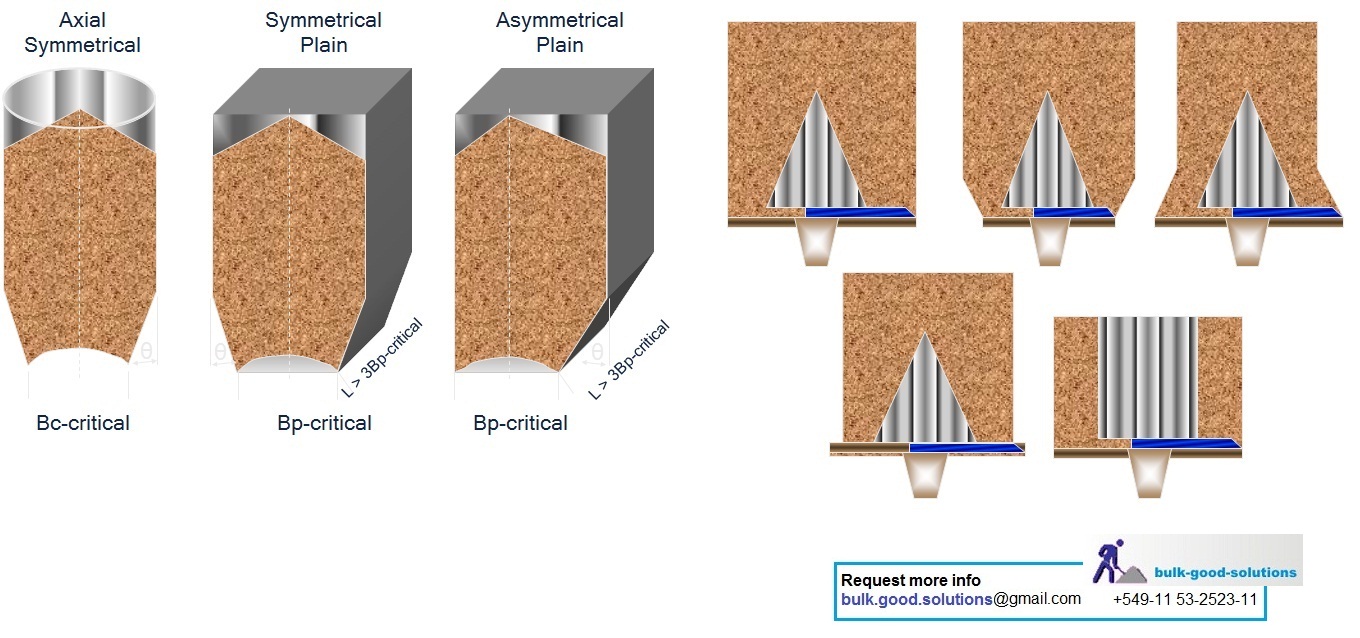
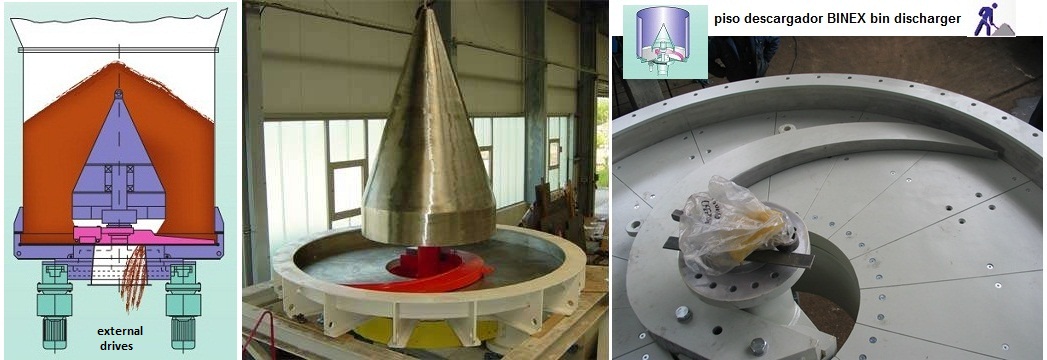
up to Ø5,000m or next model up to Ø12,000m (Binex, Planex)
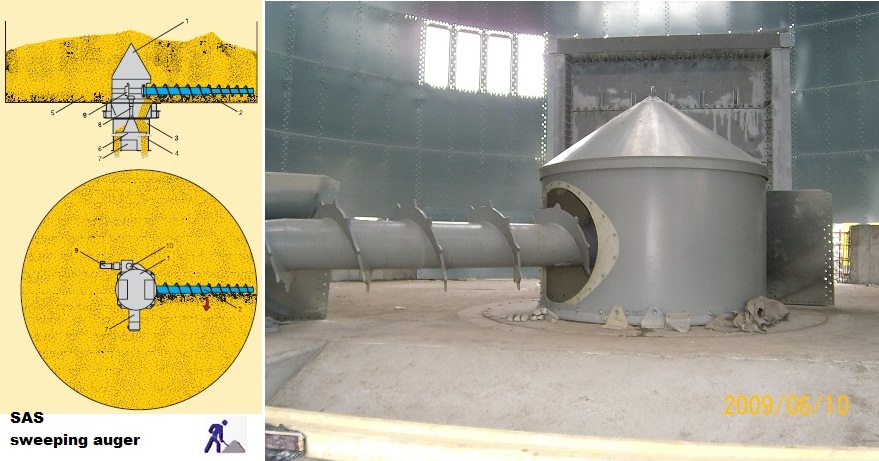
up tp Ø25,000m (SAS) -----> see video
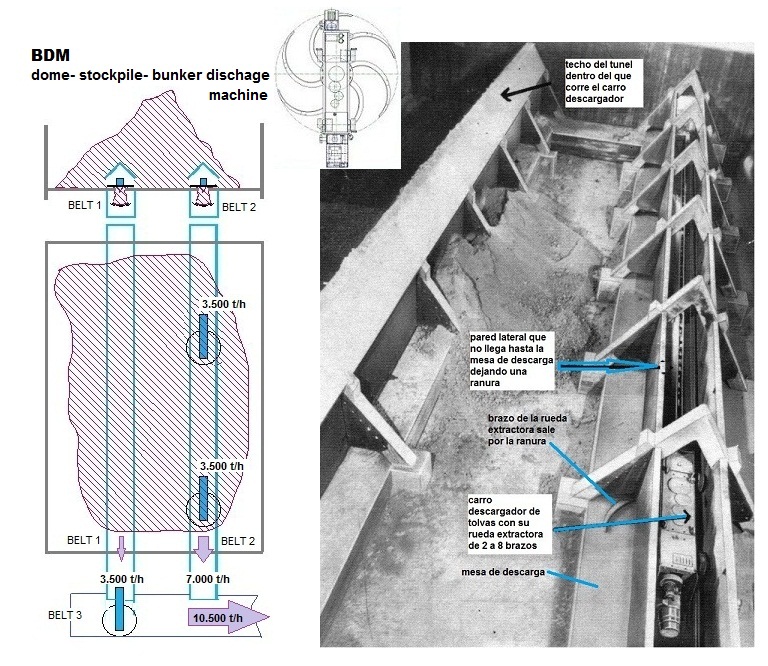
BDM/BEW runs on lengths up to L = 80 m --> see video
Hope we all that answered you get an answer ... after 10 years
dak
T +1858 5644045
M +54911 53252311
E bulk.good.solutions@gmail.com
Attachments
■












Silo discharge rate-Reg.
Sir,
Sub.: Silo discharge rate- Reg.
We have a ship loading system and handling Alumina. Our system is designed for 2000 MT/hr. We store Alumina in a concrete silo of storing capacity 22000 MT. While loading a ship, we could not extract more than 1000 MT/hr., and once the Alumina inside the silo reaches 5000 MT, we could not extract more than 400 MT/hr. from the silo. Other details in this regard are as follows,
Material handled : Calcined Alumina
Bulk density : 1.04 t/cu.m
Angle of repose : 22 deg.
Angle of surcharge : 10 deg.
Granulometry : Dry and Sandy
Size : -125 microns
Silo
Concrete in construction with flat bottom
Diameter 35 m
Wall thickness 350 mm
Height 33 m
Storing capacity 22000 MT
About 450 nos. of open Air slides of size 200 mm wide x 2.5 m long x 100 mm height are installed at 8 deg. Slope on silo floor. These 450 Air slides are divided into 8 segments for aeration (56 Air slides in each segment)
Aeration is through cyclic PCV’s for opposite segments at a time (2 segments in total) for a period of 5 min.
Silo discharge is through a distributor of Dia. 3 m with synthetic fabric installed at the centre of silo and 4 nos. of Flow Control Gates.
A Steel cone is installed above the distributor in such a way that 1m gap is maintained between silo floor and cone plate.
Root Blowers
Pressure : 0.63 bar
Volume : 600 cu.m/hr.
No. Of blowers : 3
Our queries are:
1.How to improve the discharge rate
2.How to improve the discharge rate once the silo stock reaches 5000 MT
3.How to reduce the substantial qty. of dead stock inside the silo (about 1000 MT) ■